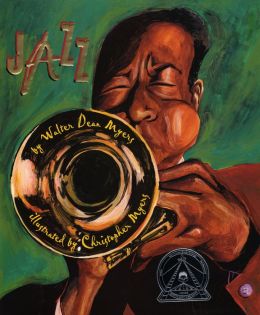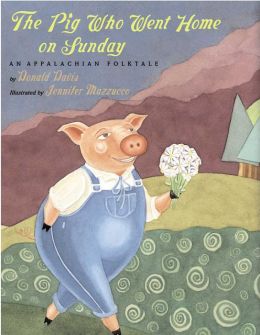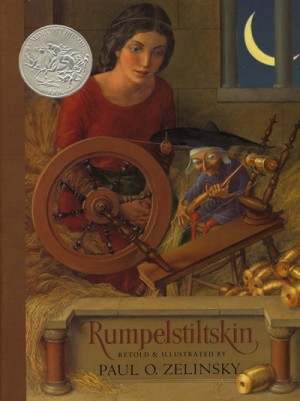
Bibliography
Myers,
Walter Dean. 2006. Jazz. Ill. by Christopher Myers. New York: Holiday
House. ISBN 978-0-8234-1545-8Plot summary
Critical analysis
Christopher Myer's
illustrations are gorgeous and joyful - he's got chops! Painted
black ink on acetate and placed over acrylic with thick and
noticeable paint brush strokes, the illustrations vibrate
with movement. Using a combination of bright, vibrant colors
and dark, moodier tones, Myer's subjects are close
up, almost like you are standing next to the artist. The
illustrations have got the groove.
The poem "Twenty-finger Jack" sums it up: "..my feet just got to dance / My heels can't follow / but my toes will take a chance." Although a few of the poems didn't have the rhythm or bounce I was expecting, I still enjoyed the tune.
Review excerpt(s)
Fifteen poems give a unique spin to music history in this title. The highly acclaimed author opens with a title poem that speaks of the African origins of jazz and "[d]rumming in tongues along the Nile," then swings to an exuberant tribute to Louie Armstrong in which that legendary trumpet player spanks a bad tune "like a naughty boy." The rhythm and word-play of poems such as "Be-Bop" and "Three Voices" will have kids bouncing and repeating lines like "[a] bippety-bop snake can't bite my style" and "[t]hum, thum, thum, and thumming/I feel the ocean rhythm coming." The illustrator brings the intensity of fluid lines and saturated color to his portraits of the jazz world... - Children's Literature
… this talented father and son have produced new poetry and paintings to explore a wider repertoire of jazz forms. An introduction provides historical and technical background, briefly touching on influences, improvisation, rhythm, and race. Spreads then pulsate with the bold, acrylic-and-ink figures and distorted perspectives that interpret the multiple moods and styles set forth in the text...The Myerses experiment aurally and visually with the forms themselves; thus, "Stride" alternates long, fast-paced lines in a white font with two-word percussive phrases in black, calling to mind a period piano score. "Be-bop" unleashes a relentlessly rhyming patter in black, punctuated by a blue cursive font that "screams." ... The expressionistic figures are surrounded by high-contrast colors in which the visible brushstrokes curve around their subjects, creating an aura that almost suggests sound waves...- School Library Journal
A
cycle of 15 poems and vivid, expressive paintings celebrate that most American
genre of music: jazz. Myers presents readers with poems that sing like their
subject, the drumming of African rhythms leading into a celebration of Louis
Armstrong, an evocation of stride piano, a recreation of a New Orleans jazz
funeral and a three-part improvisation among bass, piano and horn. A
script-like display type appears sparingly, guiding readers to the sound of
jazz embedded in the poems' syncopated rhythms. Myers fils uses bold colors and
lines straight from the muralists of the '30s to create his illustrations,
dramatic foreshortening and exaggerated angles a visual complement to the
pulsing sounds being celebrated. It's a very different look and treatment from
that given to their earlier blues journey (2003), although equally successful
at giving readers a visceral sense of its musical subject. A lengthy
introduction, glossary and timeline give background to the whole. This offering
stands as a welcome addition to the literature of jazz: In a genre all too
often done poorly for children, it stands out as one of the few excellent
treatments. - Kirkus Reviews
Connections
- Play the audio book so students can hear Jazz performed by jazz vocalists James
'D Train' Williams and Vaneese Thomas. The audio book won the Odyssey Award for Excellence in Audiobook Production. ISBN 978-1430100225 -Talk about the concept of improvisation and how it's like making something up within context. As an example, you could give a basic story structure; i.e., there is a boy who went to a store and then he went home to take a nap. As long as the basic structure of the story is there, the students can make up what happens "in between."
-Offer other books on jazz for students to expand their understanding of this musical form and famous jazz musicians.
- Pinkney, Andrea. Ella Fitzgerald. ISBN 9780823416790
- Pinkney, Andrea. Duke Ellington. ISBN 9780786814206
- Ehrhardt, Karen. This jazz man. ISBN 9780152053079
- Myers,
Walter Dean. The blues of Flats Brown. ISBN 9780823416790
- Marsalis, Wynton. Jazz ABZ: An A to Z Collection of Jazz Portraits with Art Print. ISBN 978- 0763634346
- Monceaux, Morgan. Jazz: My music, my people. ISBN 978-679856184
- Dillion, Leo & Diane. Jazz on a Saturday night. ISBN 0-590478931
- This book would work well as a collaboration with the music teacher on a unit for jazz music.
- Monceaux, Morgan. Jazz: My music, my people. ISBN 978-679856184
- Dillion, Leo & Diane. Jazz on a Saturday night. ISBN 0-590478931
- This book would work well as a collaboration with the music teacher on a unit for jazz music.



